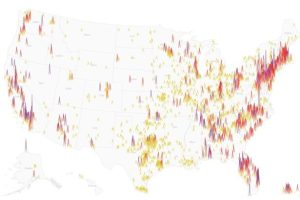Alarming new data from the Environmental Protection Agency indicates that 46million Americans could be consuming drinking water contaminated with dangerous forever chemicals





Millions of Americans are likely drinking water contaminated with “forever chemicals” as a chilling map reveals hundreds of towns with polluted water supplies.
New test results released by the Environmental Protection Agency last week displayed alarming results, finding that 839 water systems across the US exceed the yearly average EPA limits for two types of forever chemicals, also known as PFAS.
The EPA is coming to end of its largest-ever PFAS testing initiative, a three-year project that has required most public water drinking systems who serve at least 3,300 customers to test for and report measurements of several types of the forever chemicals.
The map above shows public drinking water systems that have recently submitted test results for forever chemicals to the EPA. Yellow spikes indicate areas where PFAS have been detected but are under the annual limit, while red indicates ares where forever chemicals are over the limit and purple shows regions where levels are well over the limit. Larger spikes indicate higher concentrations.
What are forever chemicals?
“Forever chemicals” is the nickname given to PFAS, which stands for per- and polyfluoroalkyl substances, because they are nearly indestructible. They are a large group of man-made chemicals which have been used in consumer products around the globe since about the 1940s.
The chemicals, which repel water, oil and grease, are used in products ranging from dental floss to cookware, clothes, and firefighting foam. There are thousands of different PFAS, Perfluorooctanoic Acid (PFOA) and Perfluorooctane Sulfonate (PFOS) are among the most widely used and studied, according to the EPA.
PFAS break down very slowly over time, and due to their persistence in the environment, many are found in the blood of people and animals. They can also be found in water, food, air and soil around the world.
Are PFAS dangerous?
Studies have shown that exposure to some PFAS may be linked to harmful health effects in humans and animals. In 2022, the EPA found that the chemicals could cause harm at levels “much lower than previously understood,” concluding that almost no level of exposure was safe.
According to the agency, peer-reviewed scientific studies have linked PFAS to:
Water systems serving 46 million Americans exceed PFAS limits
New data released by the EPA indicates that water systems that serve 46 million Americans across the US have levels of PFAS that exceed the agency’s yearly limits.
In 2,470 water systems, PFAS were detected but levels were not over the annual limit. However, a total of 597 systems measured chemicals up to three times above the limit when an entire years results were averaged, while 242 water systems measured forever chemicals from 3 to 86 times over the limit.
Larger water utilities more frequently fail to meet the EPA’s standards, USA Today reports, which nearly a quarter of systems serving more than 100,000 people exceeding the limit.
However, the latest data release shows that some of the most staggering concentrations of forever chemicals in drinking water have been reported in smaller communities.
For example, one well in Nashville, North Carolina, a town of just 6,000 people, reported PFOS at 490 parts per trillion (ppt) last fall and then at 200 ppt in March, putting the average at 86 times over the EPA’s 4 ppt limit.
Meanwhile, the borough of Emmaus, home to around 12,000 people and located outside Allentown, Pennsylvania, reported several wells over EPA limits. This included its waterworks building, where PFOS averaged 32 times over the limit.
EPA orders local governments to remove PFAS from water systems
In 2024, the US government imposed its first-ever nationwide restrictions on six harmful PFAS found in drinking water.
The EPA issued a rule requiring communities to test and treat water for the chemicals. The agency said it will “prevent thousands of deaths and reduce tens of thousands of serious PFAS-attributable illnesses”.
“Drinking water contaminated with PFAS has plagued communities across this country for too long,” EPA administrator Michael Regan said at the time. Initially, the regulations gave local municipalities a deadline of 2029 to remove PFAS found in the water, however, in May EPA announced plans for an extension.
The agency also rescinded limits on four of the six types of PFAS. The EPA still plans to limit PFOA and PFOS.
Leave a Reply